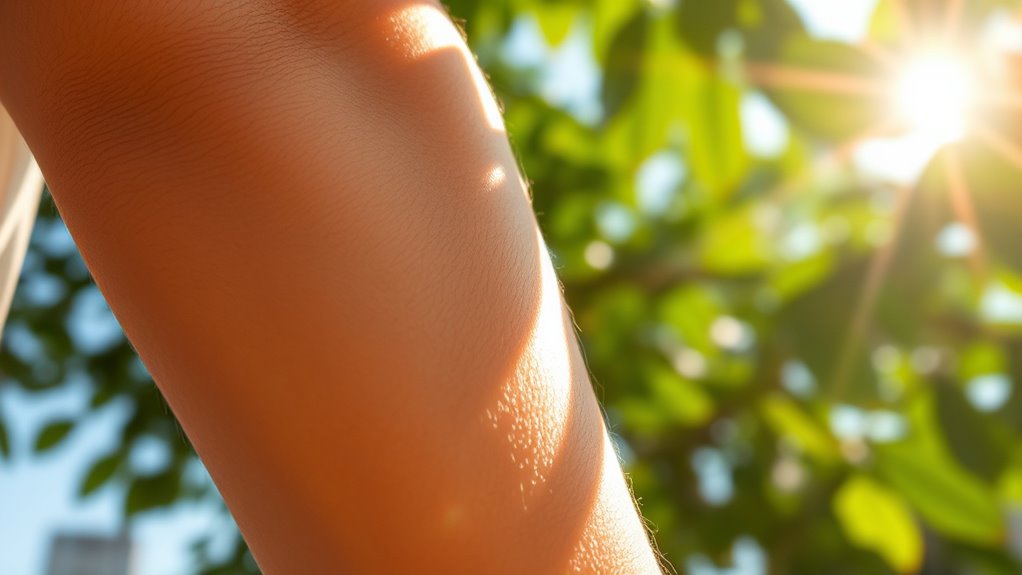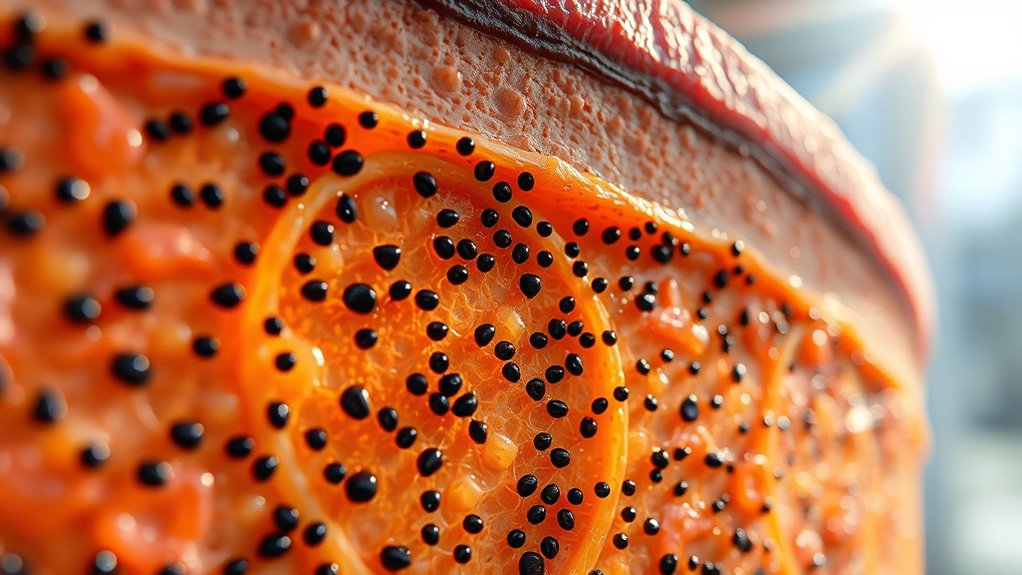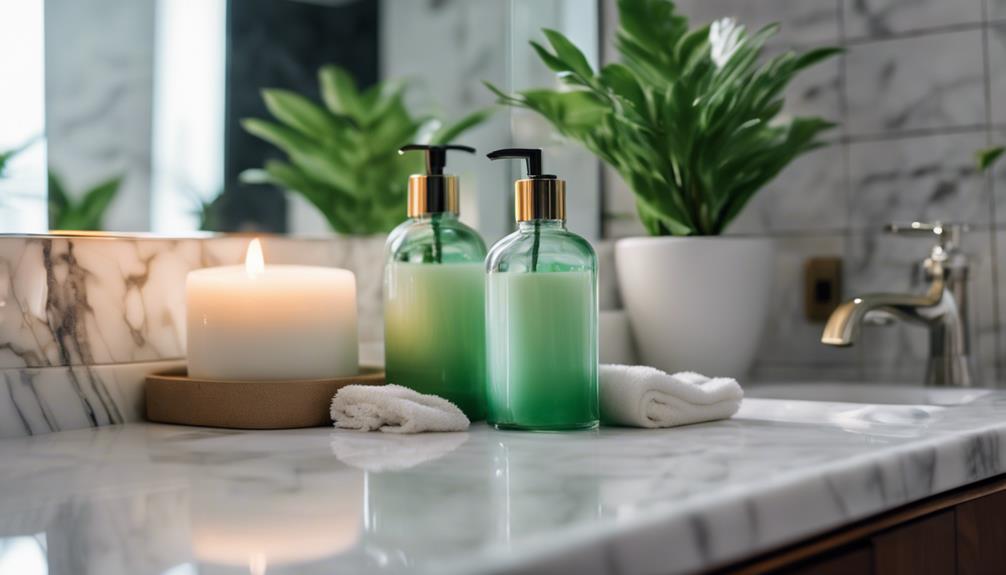When your skin is exposed to UV radiation from the sun, it triggers a biological response that boosts melanin production in specialized cells called melanocytes, located in the basal layer of your epidermis. This increased melanin absorbs and blocks UV rays, acting as a natural defense mechanism and causing your skin to darken into a tan. Understanding this process reveals how your body protects itself, and if you want to learn more about this fascinating response, keep exploring the science behind it.
Key Takeaways
- UV rays damage DNA in skin cells, triggering a protective response that increases melanin production.
- Melanocytes, located in the basal epidermis, synthesize melanin when stimulated by UV exposure.
- The transferred melanin to keratinocytes results in skin darkening, forming a tan as a defense mechanism.
- Melanin absorbs UV radiation, shielding deeper tissues and reducing potential skin damage.
- The tanning process develops gradually over days, reflecting the skin’s adaptation to UV-induced stress.

Have you ever wondered what causes your skin to change color when you spend time in the sun? It all comes down to how your skin responds to UV effects. When ultraviolet (UV) rays from the sun hit your skin, they trigger a series of biological reactions that lead to the production of melanin, the pigment responsible for your skin’s color. This process is your body’s natural way of protecting itself from the harmful effects of UV radiation. As UV rays penetrate the skin, they damage the DNA in skin cells, prompting your body to respond by producing more melanin. This increased melanin acts as a natural sunscreen, absorbing and dispersing UV radiation to prevent further damage.
The production of melanin begins in specialized cells called melanocytes, which are located in the basal layer of your epidermis. When these cells detect UV effects, they become more active and produce more melanin. This pigment is then transferred to neighboring keratinocytes, the predominant cells in your outer skin layer. As melanin accumulates, it gives your skin a darker appearance—what you recognize as a tan. The more UV exposure you get, especially during prolonged or intense sun exposure, the more melanin your melanocytes produce. This is why your skin darkens over time when you spend hours outside, giving you that coveted tan.
It’s important to understand that melanin production is a protective response, not just a cosmetic change. Your skin is trying to shield deeper tissues from UV damage, which can lead to burns, premature aging, or even skin cancer if you’re not careful. That’s why, when UV effects are intense or prolonged, your skin’s melanin levels increase considerably, resulting in a deeper tan. However, this process isn’t instantaneous; it takes several days for your skin to fully develop a tan because melanin synthesis and distribution take time.
While a tan might seem like a sign of health or leisure, it’s essentially your skin’s way of trying to repair and protect itself. The key player here is melanin production, stimulated by UV effects, which highlights how your body adapts to environmental stressors. Being aware of this process helps you understand why moderation in sun exposure is crucial. Too much UV radiation, despite triggering melanin production, can overwhelm your skin’s defenses and cause lasting damage. So, next time you bask in the sun, remember that your body is working hard behind the scenes, producing melanin in response to UV effects to give you that tan while trying to keep your skin safe.
Frequently Asked Questions
Can Tanning Be Achieved Without UV Exposure?
No, tanning isn’t achievable without UV exposure naturally, but artificial tanning offers a different route. By using self-tanners or sprays, you activate melanin synthesis without UV rays, creating a sun-kissed glow. Imagine a golden sunset in your hand, mimicking the sun’s warmth—this is what artificial tanning provides. It’s a safe alternative that produces a tan, giving you that radiant look without risking skin damage from UV radiation.
How Does Sunscreen Affect Melanin Production?
Sunscreen affects melanin synthesis by blocking UV rays, which stimulates melanin production. When you apply sunscreen, it reduces UV exposure, preventing your skin from triggering excess melanin synthesis. This means less tanning and helps protect your skin from damage. The effectiveness of sunscreen depends on its SPF and broad-spectrum coverage, ensuring your skin stays safe while minimizing melanin production caused by UV radiation.
Does Skin Type Influence Tanning Response?
Imagine your skin as a unique canvas, each stroke shaped by genetic factors and skin adaptations. Your skin type directly influences your tanning response; lighter skin reacts quickly, turning a delicate pink, while darker skin develops a deeper, richer hue. These variations stem from your genetic makeup, which determines how your skin produces melanin. So, yes, your skin type plays a crucial role in how you tan and adapt to UV exposure.
What Are the Long-Term Effects of UV Exposure?
Long-term UV exposure can accelerate skin aging, leading to wrinkles, age spots, and loss of elasticity. It also increases your risk of skin cancer, including melanoma, basal cell, and squamous cell carcinomas. Protect your skin by wearing sunscreen, seeking shade, and avoiding peak sun hours. Consistent UV damage can substantially harm your skin’s health and appearance over time, so taking preventive measures is essential for long-term well-being.
Are There Safer Alternatives to Tanning?
Imagine you’re in the 1920s, still thinking a tan’s a sign of glamour. The truth is, safer alternatives exist—like using self-tanning lotions, sprays, or opting for spray tans. These options provide a glow without exposing your skin to harmful UV rays. Remember, many tanning myths suggest UV exposure is the only way to get a bronzed look, but natural skin protection methods are just as effective and much safer.
Conclusion
Now that you understand how UV radiation sparks melanin production, you see that a tan isn’t just about beauty—it’s your skin’s clever defense. But remember, this fleeting shield comes with risks. As the sun paints its golden brushstrokes, think of your skin as a canvas that’s both resilient and delicate. Protect it wisely, for in the dance between light and life, knowledge is your best armor.









